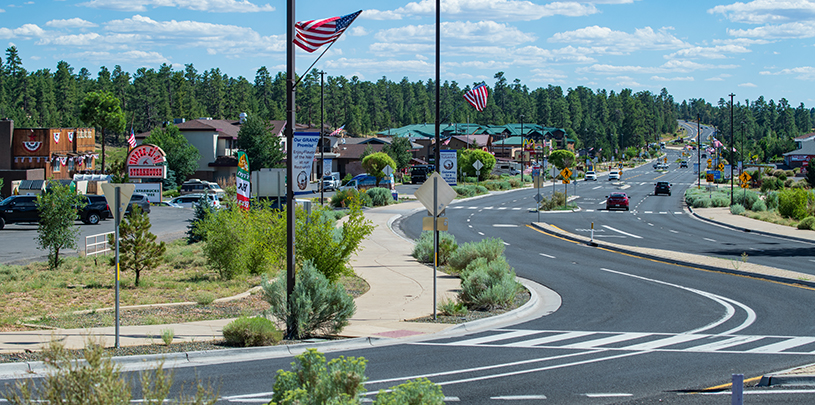
 by Roger Clark, Grand Canyon Director
by Roger Clark, Grand Canyon Director
The Grand Canyon’s busiest gateway is one step closer to being bulldozed by a mega-developer bent on putting profit above the public interest. After years of rejecting a proposal to more than double the size of the town of Tusayan on the doorstep of Grand Canyon National Park, the U.S. Forest Service has said it is ready to discuss options for processing the developer’s application.
While many details of the project remain undisclosed, the Stilo Development Group and the town of Tusayan plan to build resort hotels, shopping centers, rental housing, an RV park, conference center, and a dude ranch on two privately-owned parcels within the incorporated town of Tusayan. About 52 acres of national forest land would be disturbed to pave roads and run utilities to these developments. That’s where the Forest Service comes in — the project cannot proceed without the agency’s approval of easements to build and operate the roads and utility lines.

This week, the Forest Service accepted Stilo and the town of Tusayan’s proposal for easements. Basically, this means that the Forest Service has determined that the proposal satisfies preliminary screening criteria, and now the “proposal” becomes an “application.” The agency notes that acceptance of the proposal does not mean the easements will be authorized, but rather will allow the agency to take a more in-depth look at the project’s impacts and solicit public input to make a final decision.
The next step is for Stilo and the town to provide additional information before the Forest Service conducts a thorough analysis of the application's potential effects on Grand Canyon National Park and the surrounding national forest lands.
In its acceptance letter, the Forest Service says it needs more details from Stilo about its proposed development to fully evaluate the project’s impacts and the feasibility of the easements.
Of particular concern are missing details about plans for supplying water and handling sewage. While Stilo stated that it anticipates hauling water to its 1.8 million square feet of new commercial development, the company has not disclosed the source of water or addressed the feasibility of running more than 45 tanker trucks roundtrip, every day, to satisfy peak season water demand.
If Stilo plans to build a pipeline across forest service land to move millions of gallons of sewage to Tusayan’s treatment plant, the town must confirm the facility’s capacity to properly process it.
We don’t know how long it will take for Stilo and Tusayan to provide all of the information needed before the Forest Service initiates an environmental review under the National Environmental Policy Act (NEPA). We do know that, once the NEPA process commences, the public will have an opportunity to review and comment on the easement application and the proposed development’s impacts. Scoping, the initial step of the NEPA review process, will likely begin in a few months.
Four years ago, the Forest Service rejected a similar proposal from Stilo after receiving thousands of public comments submitted by the Havasupai Tribe, the National Park Service, and concerned citizens across the country.
In the coming months, we will call on you again to speak up for the Grand Canyon. Together, we can protect our crown-jewel national park and its precious waters. Please stand steadfast and vigilant with us as this multi-year process continues.
The Colorado River below Glen Canyon Dam is heating up. Find out why.
Read MoreGroundwater pumping at a uranium mine near the Grand Canyon will affect the canyon's springs, scientists says.
Read MoreArizona Governor Katie Hobbs is the latest elected official to call for an environmental review of Pinyon Plain uranium mine.
Read More